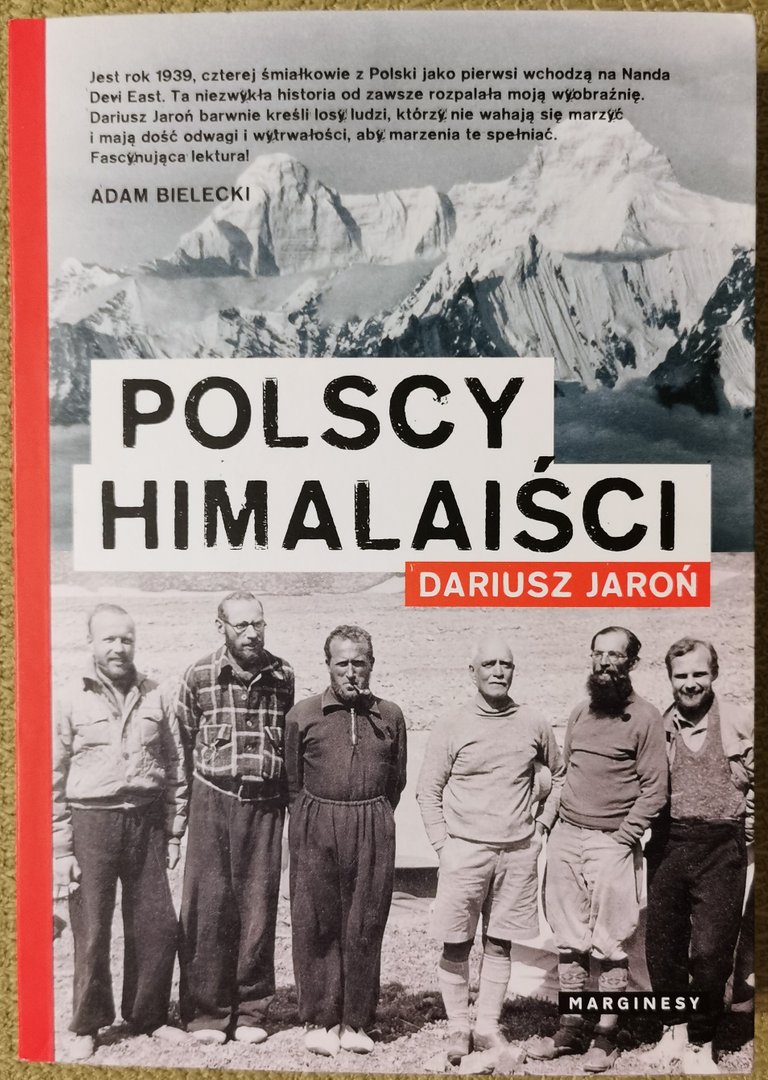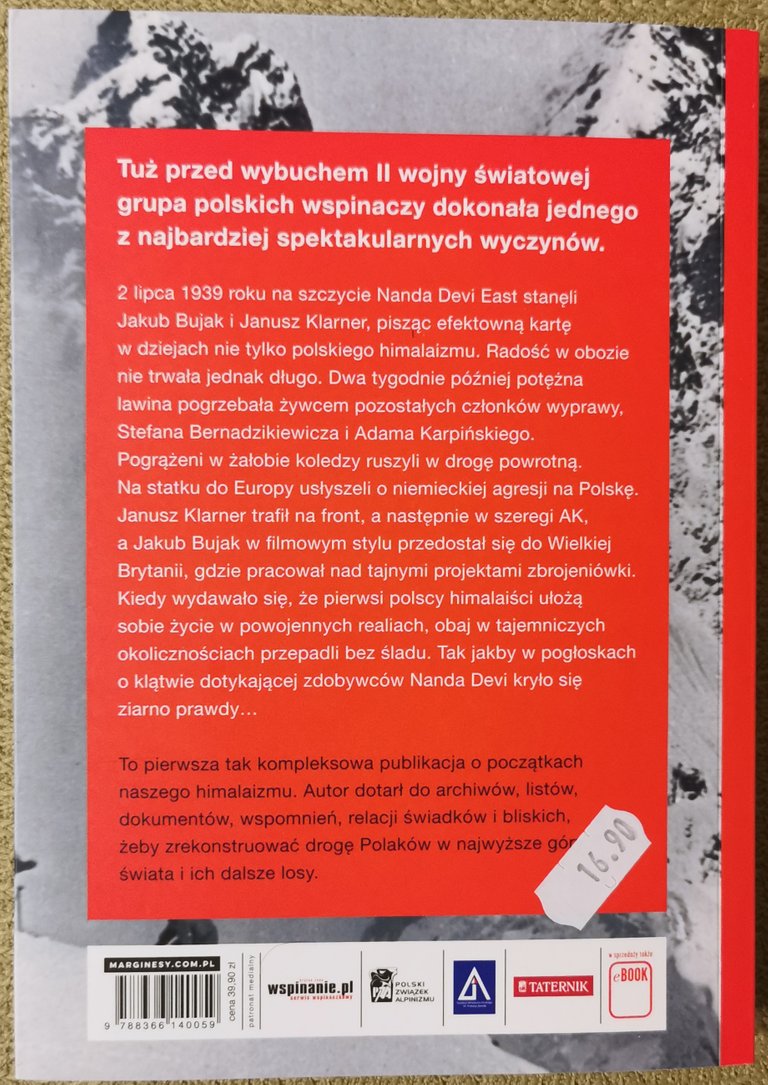| Książka przedstawia historię trudnych początków polskiego himalaizmu. Droga do późniejszych sukcesów Kukuczki, Meissnera, Wielickiego i innych rozpoczęła się w wielkim trudzie, dawno temu, hen pod samiućkimi Tatrami. A o tym, jak przebiegała, kto stał na jej początku i jak się zakończyła – opowiada nam autor książki. |
The book tells the story of the difficult beginnings of Polish Himalayan mountaineering. The road to the later successes of Kukuczka, Meissner, Wielicki and others began in great difficulty, long ago, in the Tatra Mountains. How this road began, who stood at its beginning and how it ended - we are told by the author of the book. |
| Marzenia polskich wspinaczy o Himalajach zaczęły nabierać konkretniejszych kształtów w latach 30. XX wieku. Wtedy to polskie Tatry zaczęły już być dla nich za ciasne, a sprzyjające okoliczności zaczęły pozwalać na coraz dalsze wyprawy, w coraz bardziej egzotyczne i wyższe góry – po Alpach i Kaukazie przyszedł czas na Andy, na przełomie lat 1933/34. Gdy i ta wyprawa zakończyła się sukcesem, stało się jasne, że można zaczynać myśleć o najwyższych górach świata. |
The dreams of Polish climbers about the Himalayas began to take solid shape in the 1930s. At that time, the Polish Tatra Mountains started to become too small for them, and thanks to favourable circumstances, expeditions to more and more exotic and higher mountains became possible - after the Alps and the Caucasus, the time for the Andes came at the turn of 1933/34. When this expedition also ended successfully, it became clear that thoughts of the highest mountains in the world could begin. |
| Pierwotne plany były wyjątkowo ambitne i zakładały próbę zdobycia drugiej najwyższej góry na świecie – K2 w Karakorum (wszyscy bowiem byli świadomi, że Brytyjczycy nie zgodzą się, by ktoś próbował ich ubiec w wejściu na Mount Everest). Jednak i tu na przeszkodzie stanęły względy logistyczne i organizacyjne. Okazało się mianowicie, że władze miejscowe wydawały zaledwie jedno pozwolenie wspinaczkowe rocznie, a pierwszeństwo w jego uzyskaniu przypadało wspinaczom bardziej doświadczonym. Polacy stanęli przed perspektywą wieloletniego oczekiwania lub... zmiany planów. Wybrali zmianę. |
The original plans were extremely ambitious and included an attempt to climb the second highest mountain in the world, K2 in the Karakorum (for everyone was aware that the British would not accept anyone trying to outdo them in climbing Mount Everest). However, again, this was hindered by logistics and administrative reasons. Namely, it turned out that the local authorities only used to grant one mountaineering permit a year, and that priority in obtaining one was given to more experienced climbers. The Poles were faced with the prospect of waiting for years or... change of plans. They chose the change. |
| Ostatecznym celem ekspedycji, zaakceptowanym przez władze miejscowe, stał się niezdobyty do tamtej pory szczyt Nanda Devi East w Himalajach Garhwalu – może i nie ośmiotysięcznik, ale ich epoka zaczęła się przecież dopiero w 1950... Polska ekspedycja w składzie: Adam Karpiński, Stefan Bernadzikiewicz, Jakub Bujak oraz Janusz Klarner wyruszyła do Indii w kwietniu 1939. Autor malowniczo przedstawia sylwetki bohaterów i losy wyprawy, uwzględniając wszelkie trudy i radości z nimi związane – od olbrzymich trudności logistycznych, przez problemy zdrowotne, aż po wysiłki już ściśle związane ze wspinaczką w dziewiczym terenie i satysfakcję ze zdobycia szczytu. |
The final goal of the expedition, accepted by the local authorities, became the still-unclimbed summit of Nanda Devi East in the Garhwal Himalayas - maybe it wasn't an eight-thousander, but after all, their era had only begun in 1950.... The Polish expedition comprising: Adam Karpiński, Stefan Bernadzikiewicz, Jakub Bujak and Janusz Klarner set off for India in April 1939. The author picturesquely presents their profiles and the fate of the expedition, taking into account all the hardships and joys involved - from the enormous logistical difficulties, through health problems, to the efforts strictly connected with climbing in virgin terrain and the satisfaction of reaching the summit. |
| Kto wie, jak potoczyłyby się losy bohaterów, gdyby już wtedy postanowili wracać do kraju? Jednak, zachęceni sukcesem, postanowili kontynuować ekspedycję i udać się pod niezbadany masyw Tirsuli w dolinie Milam, by również tam spróbować zapisać chwalebne karty w historii polskiej wspinaczki. Niestety, tym razem szczęście nie dorównało umiejętnościom. Dwóch uczestników wyprawy nigdy już nie wróciło do swoich domów i rodzin... |
Who knows what the fate of the people involved would have been like if they had decided to return to the country at that point? They were however encouraged by their success and decided to continue the expedition heading for the unexplored Tirsuli massif in the Milam valley, in order to try to write glorious pages in the history of Polish mountaineering also there. Unfortunately, this time luck was no match for skill. Two participants of the expedition never returned to their homes and families.... |
| Autor nie porzuca bohaterów wraz z zakończeniem wyprawy. Próbuje zrekonstruować losy tych, którzy przeżyli, w burzliwych czasach II wojny światowej i realiów, jakie nastąpiły po niej – do momentów, w których obaj znikli bez śladu: jeden w komunistycznej Polsce, drugi w Wielkiej Brytanii, gdzie pracował w sektorze zbrojeniowym. |
The author does not abandon the protagonists with the end of the expedition. He attempts to reconstruct the fates of the survivors during the turbulent times of the Second World War and the realities that followed - up to the moments when they both disappeared without a trace: one in communist Poland, the other in the UK, where he worked in the arms sector. |
| Książka – oprócz samej warstwy narracyjnej – zawiera cenne materiały archiwalne w postaci zdjęć z wyprawy, map, kopii wszelkiego rodzaju dokumentów i akt. Dzięki temu mamy możliwość poznać ten wycinek historii w maksymalnie szczegółowy sposób. |
The book - in addition to the narrative layer itself - contains valuable archival material in the form of photographs taken during the expedition, maps, copies of all kinds of documents and dossiers. This allows us to get to know this slice of history in maximum detail. |
 )
)
